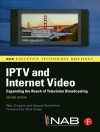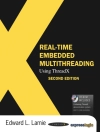This book provides an in-depth guide to femtocell
technologies
In this book, the authors provide a comprehensive and organized
explanation of the femtocell concepts, architecture, air interface
technologies, and challenging issues arising from the deployment of
femtocells, such as interference, mobility management and
self-organization. The book details a system level simulation based
methodology addressing the key concerns of femtocell deployment
such as interference between femto and macrocells, and the
performance of both femto and macrocell layers. In addition, key
research topics in interference modeling and mitigation, mobility
management and Self-Organizing Network (SON) are highlighted. The
authors also introduce HNB/He NB standardization in 3GPP..
Furthermore, access methods (closed, open and hybrid),
applications, timing synchronization, health issues, business
models and security are discussed. The authors also provide a
comparison between femtocells and other indoor coverage techniques
such as picocells, repeaters, distributed antenna systems and radio
over fiber. Lastly, both CDMA and OFDMA based femtocells are
covered.
Key Features:
* Provides a comprehensive reference on femtocells and related
topics
* Offers the latest research results on femtocells based on
simulation and measurements
* Gives an overview of indoor coverage techniques such as
picocells, repeaters, distributed antenna systems, radio over fiber
and femtocells
* Includes chapters on femtocell access network architecture, air
interface technologies (GSM, UMTS, HSPA, Wi MAX and LTE), femtocell
simulation, interference analysis and mitigation in femto/macrocell
networks, mobility management in femto/macrocell networks,
femtocell self-organization and other key challenges such as timing
synchronization and security faced by femtocell deployment
* Points to over 240 references from 3GPP, The Femto Forum,
journals and conference proceedings
This book will be an invaluable guide for RF engineers from
operators, R&D engineers from femtocells hardware
manufacturers, employees from regulatory bodies, radio network
planners, academics and researchers from universities and research
organizations. Students undertaking wireless communications courses
will also find this book insightful.
Innehållsförteckning
About the Authors.
Preface.
Acknowledgements.
Acronyms.
1 Introduction.
1.1 The Indoor Coverage Challenge.
1.2 Concepts of Femtocells.
1.3 Why is Femtocell Important?
1.4 Deployment of Femtocells.
1.5 Important Facts to Attract More Customers.
1.6 The Structure of the Book.
References.
2 Indoor Coverage Techniques.
2.1 Improvement of the Indoor Coverage.
2.2 Outdoor Cells.
2.3 Repeaters.
2.4 Distributed Antenna Systems (DAS).
2.5 Radiating or Leaky Cable.
2.6 Indoor Base Stations.
2.7 Comparison of the Indoor Coverage Techniques.
References.
3 Access Network Architecture.
3.1 Overview.
3.2 GAN Based Femtocell-to-Core Network Connectivity.
3.3 3GPP Iuh (Iu-Home) for Home Node B.
3.4 Evolution to IMS/HSPA+/LTE.
3.5 Architecture with IMS Support.
References.
4 Air-Interface Technologies.
4.1 Introduction.
4.2 2G Femtocells: GSM.
4.3 3G Femtocells: UMTS & HSPA.
4.4 OFDM-Based Femtocells.
References.
5 System-Level Simulation for Femtocell Scenarios.
5.1 Network Simulation.
5.2 Link and System Level Simulations.
5.3 Wireless Radio Channel Modeling.
5.4 Static and Dynamic System-Level Simulations.
5.5 Static System Level Methodology for Wimax Femtocells.
5.6 Coverage and Capacity Analysis for Wimax Femtocells.
5.7 Overview on Dynamic System-Level Simulation.
References.
6 Interference in the Presence of Femtocells.
6.1 Introduction.
6.2 Key Concepts.
6.3 Interference Cancellation.
6.4 Interference Avoidance.
6.5 Interference Management with UMTS.
6.6 Conclusion.
References.
7 Mobility Management.
7.1 Introduction.
7.2 Mobility Management for Femtocells in 3GPP.
7.3 Femtocell Characterization.
7.4 Access Control.
7.5 Paging Procedure.
7.6 Cell Selection and Reselection.
7.7 Cell Handover.
References.
8 Self-Organization.
8.1 Self-Organization.
8.2 Self-Configuration, Self-Optimization and Self-Healing.
8.3 Self-Organization in Femtocell Scenarios.
8.4 Start-Up Procedure in Femtocells.
8.5 Sensing the Radio Channel.
8.6 Self-Configuration and Self-Optimization of Femtocell
Parameters.
References.
9 Further Femtocell Issues.
9.1 Timing.
9.2 Femtocell Security.
9.3 Femtocell Location.
9.4 Access Methods.
9.5 Need for New Applications.
9.6 Health Issues.
References.
Index.
Om författaren
Jie Zhang is a professor of wireless communications and
networks and the director of CWi ND (Centre for Wireless Network
Design, www.cwind.org) at the
DCST (Department of Computer Science and Technology) of Uo B
(University of Bedfordshire). He joined Uo B as a Senior Lecturer in
2002, becoming professor in 2006.
He received his Ph D in industrial automation from East China
University of Science and Technology (href=’http://www.ecust.edu.cn/’>www.ecust.edu.cn), Shanghai,
China, in 1995. From 1997 to 2001, he was a postdoctoral research
fellow with University college London, Imperial College London, and
Oxford University.
Guillaume de la Roche has been working as a research
fellow at the Centre for Wireless Network Design (UK) since 2007.
He received the Dipl-Ing in Telecommunication from the School of
Chemistry Physics and Electronics (CPE Lyon), France, an MSc degree
in Signal Processing (2003) and Ph D in Wireless Communication
(2007) from the National Institute of Applied Science (INSA Lyon),
France.
Alvaro Valcarce obtained is MEng in telecommunications
engineering from the University of Vigo (Spain) in 2006. During
2005 he worked at ’Telefonica I+D’ in Madrid (Spain), integrating
an applications-streaming platform into an ’ATG Dynamo Server’, as
well as developing a system for applications-on-demand’.
David Lopez-Perez received his bachelor and master
degrees in telecommunication from Miguel Hernandez University,
Elche, Alicante (Spain) in 2003 and 2006, respectively. He joined
Vodafone Spain in 2005, working at the Radio Frequency department
in the area of network planning and optimization. he participated
in the development of the Vodafone Automatic Frequency Planning
tool for GSM and DCS networks.
Enjie Liu is a Senior Lecturer at the Department of
Computer Science and Technology of the University of Bedfordshire.
She joined Uo B in 2003. She is a member of the Networking teaching
group in the department and responsible for delivering both wired
and wireless modules to undergraduates as well as post graduates.
She received her Ph D from Queen Mary College, University of London
in 2002. Then she worked as research fellow with the Centre for
Communication Systems Research (CCSR), the University of Surrey.
She was grated a Newly Appointed Lecturers Award by The Nuffield
Foundation.
Hui Song is a Ph D student and research associate at the
Center for Wireless Network Design (CWi ND), University of
Bedfordshire. His interests is network planning and optimization
technologies. His current focus is on modeling OFDM fading
channels. before joining CWi ND, he was the manager of eh technology
department at Bynear Telecom Software Ltd, Shanghai, China. There
he was responsible for developing and maintaining the nation-first
network planning and optimization suite (including GSM, WCDMA and
TD-SCDMA). Song holds a mathematics degree from Fudan University,
Shanghai, China. He currently resides in the United Kingdom.












